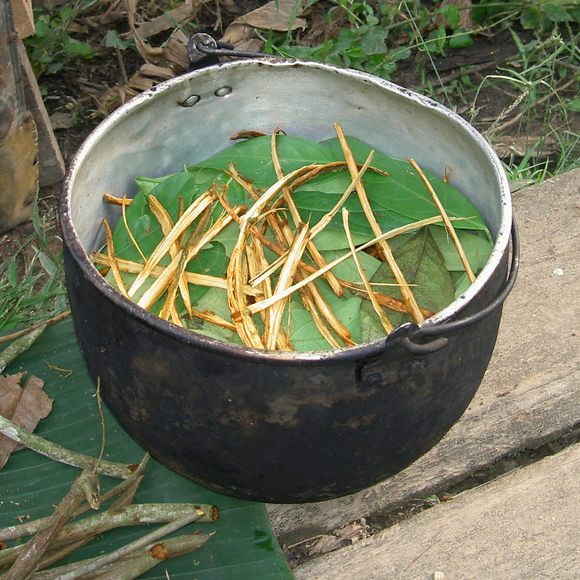For centuries, indigenous Amazonian cultures have relied on the union of a vine and a shrub to create a sacred, mind-altering experience known as ayahuasca. Shamans gently boil the plants together for hours to make a potent brew.
Though experiences vary, those who drink the bitter mixture will typically feel its effects for four to six hours. During that time, they may experience intense vomiting and a far-ranging series of emotions and visions. Users report feeling a deep connection to the universe, dream-like states, awe, sadness, and happiness (sometimes simultaneously). They might also gain insight into personal memories and concerns.
Although the ayahuasca vine has no hallucinatory properties, its bark has the unique power to unlock the psychedelic potential in other plants. Here, that other plant is the chacruna shrub. Its leaves contain the altered state–inducing chemical known as N,N-Dimethyltryptamine (DMT). Normally, enzymes in your body break down chemicals like DMT. Ayahuasca, however, contains molecules that inhibit those enzymes and allow the DMT to reach your brain.
Many indigenous tribes throughout the northwestern Amazon Basin, encompassing Colombia, Peru, Ecuador, and Brazil, use ayahuasca for ceremonies, spiritual communion, and purging. Ceremonial specialists known as ayahuasqueros may use the DMT-containing Diplopterys cabrerana vine or add other psychoactive plants, such as the sometimes-fatal chiric sanango.
In Peru, ayahuasca is legal only for use during spiritual ceremonies. As of 2008, the government recognized the drink as “one of the basic pillars of the identity of the Amazon peoples.” Recently, this sacred status has been compromised by outside interest. Every year, tens of thousands of “ayahuasca tourists” from around the world visit Peru and Colombia. This influx has caused some local guides to bend to Western expectations at the expense of authenticity.
In 1999, the Union of Indigenous Ayahuasca Healers of the Colombian Amazon spoke to a larger concern that some local practitioners don’t respect the value of ayahuasca and mislead interested tourists. Neo-ayahuasqueros, those with no background in traditional use or administration, have sprung up around South America just in time for the psychedelic gold rush.
As with any ritual involving a mind-altering substance, respect and caution are essential. While overdosing is rare, some batches may contain the deadly nightshade toé, or contain no ayahuasca at all. As one one anthropologist from the Colombian Amazon says, “Being Amazonian is not any warranty that the person in question is qualified or has good intentions.” Conversely, being non-Amazonian “does not mean that the person is doing sessions mainly for financial gain. In our global world, anybody can learn anything and be able to teach it to others.”
Where to Try It
-
Temple of The Way of Light
Sargento Lores 841, Iquitos, 16000, PeruA healing center in the Amazon rainforest that offers ayahuasca retreats led by both female and male Shipibo shamans. They medically clear participants before enrolling them.
Written By
 rachelrummel
rachelrummel
Sources
- www.bbc.com/news/magazine-27203322
- www.laweekly.com/news/ayahuasca-can-change-your-life-as-long-as-youre-willing-to-puke-your-guts-out-4137305
- thethirdwave.co/ayahuasca/
- www.newyorker.com/magazine/2016/09/12/the-ayahuasca-boom-in-the-u-s
- www.vice.com/en_us/article/qbn8vq/ayahuasca-tourism-is-ripping-off-indigenous-amazonians
- www.sciencedirect.com/topics/neuroscience/monoamine-oxidase
- books.google.com/books?id=b_z8CAAAQBAJ&pg=PT117&lpg=PT117&dq=%22one+of+the+basic+pillars+of+the+identity+of+the+Amazon+peoples%22&source=bl&ots=uB9IFvR52C&sig=x3mmDODC4zJer61bw31dK3w5HKA&hl=en&sa=X&ved=0ahUKEwjBkJzIwuLYAhVJ_IMKHS9mAfoQ6AEIJzAA#v=onepage&q=%22one%20of%20the%20basic%20pillars%20of%20the%20identity%20of%20the%20Amazon%20peoples%22&f=false
- erowid.org/plants/diplopterys/
- www.culturalsurvival.org/publications/cultural-survival-quarterly/ayahuasca-shamanism-shared-across-cultures
- www.kahpi.net/is-ayahuasca-an-ancient-tradition/
- www.ayahuasca.com/psyche/shamanism/what-indigenous-groups-traditionally-use-ayahuasca/
- www.theguardian.com/travel/2016/jun/07/peru-ayahuasca-drink-boom-amazon-spirituality-healing

















